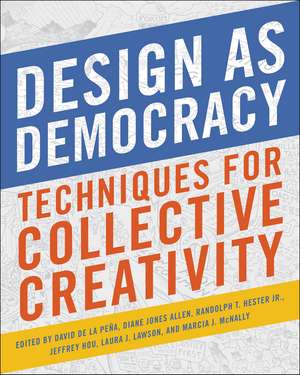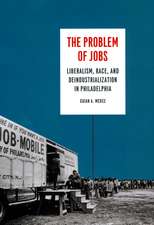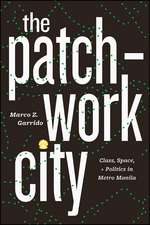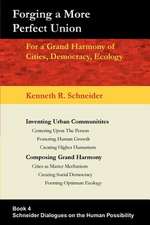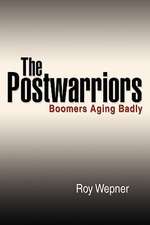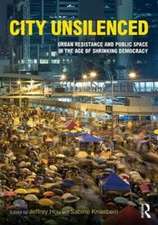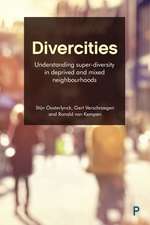Design as Democracy: Techniques for Collective Creativity
Editat de David de la Pena, Diane Jones Allen, Randolph T. Hester, Jr., Jeffrey Hou, Laura J. Lawson, Marcia J. McNallyen Limba Engleză Paperback – 7 dec 2017
Winner of the Environmental Design Research Association's 2018 Book Award
How can we design places that fulfill urgent needs of the community, achieve environmental justice, and inspire long-term stewardship? By bringing community members to the table, we open up the possibility of exchanging ideas meaningfully and transforming places powerfully. Collaboration like this is hands-on democracy in action. It’s up close. It’s personal. For decades, participatory design practices have helped enliven neighborhoods and promote cultural understanding. Yet, many designers still rely on the same techniques that were developed in the 1950s and 60s. These approaches offer predictability, but hold waning promise for addressing current and future design challenges. Design as Democracy: Techniques for Collective Creativity is written to reinvigorate democratic design, providing inspiration, techniques, and case stories for a wide range of contexts.
Edited by six leading practitioners and academics in the field of participatory design, with nearly 50 contributors from around the world, Design as Democracy shows how to design with communities in empowering and effective ways. The flow of the book’s nine chapters reflects the general progression of community design process, while also encouraging readers to search for ways that best serve their distinct needs and the culture and geography of diverse places. Each chapter presents a series of techniques around a theme, from approaching the initial stages of a project, to getting to know a community, to provoking political change through strategic thinking. Readers may approach the book as they would a cookbook, with recipes open to improvisation, adaptation, and being created anew.
Design as Democracy offers fresh insights for creating meaningful dialogue between designers and communities and for transforming places with justice and democracy in mind.
How can we design places that fulfill urgent needs of the community, achieve environmental justice, and inspire long-term stewardship? By bringing community members to the table, we open up the possibility of exchanging ideas meaningfully and transforming places powerfully. Collaboration like this is hands-on democracy in action. It’s up close. It’s personal. For decades, participatory design practices have helped enliven neighborhoods and promote cultural understanding. Yet, many designers still rely on the same techniques that were developed in the 1950s and 60s. These approaches offer predictability, but hold waning promise for addressing current and future design challenges. Design as Democracy: Techniques for Collective Creativity is written to reinvigorate democratic design, providing inspiration, techniques, and case stories for a wide range of contexts.
Edited by six leading practitioners and academics in the field of participatory design, with nearly 50 contributors from around the world, Design as Democracy shows how to design with communities in empowering and effective ways. The flow of the book’s nine chapters reflects the general progression of community design process, while also encouraging readers to search for ways that best serve their distinct needs and the culture and geography of diverse places. Each chapter presents a series of techniques around a theme, from approaching the initial stages of a project, to getting to know a community, to provoking political change through strategic thinking. Readers may approach the book as they would a cookbook, with recipes open to improvisation, adaptation, and being created anew.
Design as Democracy offers fresh insights for creating meaningful dialogue between designers and communities and for transforming places with justice and democracy in mind.
Preț: 358.58 lei
Nou
Puncte Express: 538
Preț estimativ în valută:
68.61€ • 71.83$ • 56.77£
68.61€ • 71.83$ • 56.77£
Carte disponibilă
Livrare economică 15-29 martie
Livrare express 01-07 martie pentru 51.30 lei
Preluare comenzi: 021 569.72.76
Specificații
ISBN-13: 9781610918473
ISBN-10: 1610918479
Pagini: 344
Ilustrații: Full color, 143 photos and illustrations
Dimensiuni: 203 x 254 x 20 mm
Greutate: 0.82 kg
Ediția:None
Editura: Island Press
Colecția Island Press
ISBN-10: 1610918479
Pagini: 344
Ilustrații: Full color, 143 photos and illustrations
Dimensiuni: 203 x 254 x 20 mm
Greutate: 0.82 kg
Ediția:None
Editura: Island Press
Colecția Island Press
Notă biografică
David de la Peña is an architect, urban designer and Assistant Professor of Landscape Architecture at the University of California, Davis. His work and practice explore methods by which citizens and designers co-produce urban spaces, with a focus on sustainable architecture, self-managed communities, and urban agriculture in the US and Spain.
Diane Jones Allen has 27 years of professional practice experience in land planning and varied scales of community development work. She is the director of the Landscape Architecture Program at the University of Texas, Arlington. Her firm, DesignJones LLC, received the 2016 the American Society of Landscape Architects Community Service Award.
Randolph T. Hester Jr. champions cultural and biological diversity through his writing and built work in complex political environments, from Manteo, North Carolina to Los Angeles and the East Asian-Australasian Flyway.
Jeffrey Hou is Professor of Landscape Architecture at the University of Washington, Seattle. His work focuses on design activism, public space and democracy, and engagement of marginalized social groups in design and planning. He is the editor of Insurgent Public Space: Guerrilla Urbanismand the Making of Contemporary Cities (2010).
Laura J. Lawson is Dean of Agriculture and Urban Programs at Rutgers, The State University of New Jersey. Her scholarship and teaching focus on urban agriculture, community open space, and participatory design.
Marcia J. McNally is a recognized leader in international environmental mobilization and on-the-ground citizen participation. She retired from University of California, Berkeley in 2010 but continues to teach at Berkeley and in Taiwan. McNally now lives in Durham, North Carolina where she runs The Neighborhood Laboratory, an on-demand community design center.
Diane Jones Allen has 27 years of professional practice experience in land planning and varied scales of community development work. She is the director of the Landscape Architecture Program at the University of Texas, Arlington. Her firm, DesignJones LLC, received the 2016 the American Society of Landscape Architects Community Service Award.
Randolph T. Hester Jr. champions cultural and biological diversity through his writing and built work in complex political environments, from Manteo, North Carolina to Los Angeles and the East Asian-Australasian Flyway.
Jeffrey Hou is Professor of Landscape Architecture at the University of Washington, Seattle. His work focuses on design activism, public space and democracy, and engagement of marginalized social groups in design and planning. He is the editor of Insurgent Public Space: Guerrilla Urbanismand the Making of Contemporary Cities (2010).
Laura J. Lawson is Dean of Agriculture and Urban Programs at Rutgers, The State University of New Jersey. Her scholarship and teaching focus on urban agriculture, community open space, and participatory design.
Marcia J. McNally is a recognized leader in international environmental mobilization and on-the-ground citizen participation. She retired from University of California, Berkeley in 2010 but continues to teach at Berkeley and in Taiwan. McNally now lives in Durham, North Carolina where she runs The Neighborhood Laboratory, an on-demand community design center.
Cuprins
Acknowledgements
Introduction
Chapter 1: Suiting up to Shed
-What’s In It for Us? Designing a Durable Team. Julie Stevens
-I Am Someone Who. Randolph T. Hester Jr.
-Challenging the Blank Slate. Sungkyung Lee and Laura J. Lawson
-Environmental Autobiography Adaptations. Marcia J. McNally and Laura J. Lawson
-Finding Yourself in the Census. Marcia J. McNally
-Consume, Vend, and Produce. Marcia J. McNally
Chapter 2: Going to the People’s Coming
-Start by Listening. Noah Billig
-Village Talk. Hala Nassar and Paul Duggan
-Community Camera: Piga Picha. Chelina Odbert and Joe Mulligan
-Sketching Together. Richard Alomar
-El Carrito: Rolling Out the Cart. Havier Fraga Cadórniga and David de la Peña
-Pop Up Meeting. Amanda Lovelee
Chapter 3: Experting: They Know, We Know, and Together We Know Better, Later
-Cellphone Diaries: Asset Mapping with Mobile Technology. Kofi Boone
-Mining the Indigenous. Austin Allen
-The Investigative Reporter. Patsy Eubanks Owens
-Reflect, Articulate, Project (R.A.P.) Method for Sharing Community Stories. C.L. Bohannon and Terry Clements
-Adults Designing Playgrounds by Becoming Children. Yeun-Kum Kim
Chapter 4: Calming and Evoking
-Mapping the Common Living Sphere. Kota Maruya
-Visual Timeline. Sybil Diver
-Children’s Exciting Neighborhood Exploration Event. Isami Kinoshita
-Community Innovation Forum. Christian Dimmer and Yu Ohtani
-The Big Map. Chao-Ching Yu
Chapter 5: "Yeah! That’s What We Should Do"
-Prioritizing Decisions. Maren King
-Community Voting, Local Committees. Sago Network
-Getting a Gestalt. Randolph T. Hester Jr.
-In-House Aha!. Marcia J. McNally
-Renkei Method: Scaling Up by Connecting Scenes. Yokyo Tsuchiya and Masato Dohi
Chapter 6: Co-generating
-Drawing Out the Sacred, Upside Down. Randolph T. Hester Jr.
-Green Rubber Stamp. Chenyu Lien
-Design Buffet. Jeffrey Hou
-Place It Workshop. James Rojas
-Picture Collage Game. Hideaki Shimura, Kosuke Matsuo, and Shigeru Satoh
-Designing Life. Shin Aiba, Jing Jin, Akihiro Soga, and Hirotaka Ikeda
Chapter 7: Engaging the Making
-Start with Building. Alex Gilliam
-Early Success through Banner Making. Milenko Matanovic
-Pallet Furniture. Lauren Elder
-La Maqueta: Interactive Model for Studying and Imagining the City. Andrés Martínez de la Riva Díaz
-Cross-Cultural Prototyping. Kofi Boone
-Design/Build Service Learning Studio. Daniel Winterbottom
Chapter 8: Testing, Testing, Can You Hear Me? Do I Hear You Right?
-The Spatial Design Game: A Design Game That Teaches and Tests. Henry Sanoff
-Anticipated Archetypes and Unexpected Idiosyncracies. Randolph T. Hester Jr.
-Raise Your Own Sea Level. Victoria Chanse
-Machizukuri: Visualizing Sequential Futures. Naomi Uchida and Shigeru Satoh
- Preemptive Comparison. Randolph T. Hester Jr.
-Participatory Budgeting. Emily Risinger and Sara Egan
Chapter 9: Putting Power to Good Use, Delicately and Tenaciously
-Mapping Environmental Injustice. Randolph T. Hester Jr.
-Kitchen Table Work Session. Diane Allen Jones
-Power Mapping. Randolph T. Hester Jr.
-Positioning Yourself on the Spectrum of Power and Privilege. Shalini Agrawal and Shreya Shah
-Build Small, Think Structural Change. Laura J. Lawson
-Conflict in Its Time and Place. Randolph T. Hester Jr.
-Organizing a Place-Based Campaign. Randolph T. Hester Jr.
Conclusion
Contributor Biographies
Introduction
Chapter 1: Suiting up to Shed
-What’s In It for Us? Designing a Durable Team. Julie Stevens
-I Am Someone Who. Randolph T. Hester Jr.
-Challenging the Blank Slate. Sungkyung Lee and Laura J. Lawson
-Environmental Autobiography Adaptations. Marcia J. McNally and Laura J. Lawson
-Finding Yourself in the Census. Marcia J. McNally
-Consume, Vend, and Produce. Marcia J. McNally
Chapter 2: Going to the People’s Coming
-Start by Listening. Noah Billig
-Village Talk. Hala Nassar and Paul Duggan
-Community Camera: Piga Picha. Chelina Odbert and Joe Mulligan
-Sketching Together. Richard Alomar
-El Carrito: Rolling Out the Cart. Havier Fraga Cadórniga and David de la Peña
-Pop Up Meeting. Amanda Lovelee
Chapter 3: Experting: They Know, We Know, and Together We Know Better, Later
-Cellphone Diaries: Asset Mapping with Mobile Technology. Kofi Boone
-Mining the Indigenous. Austin Allen
-The Investigative Reporter. Patsy Eubanks Owens
-Reflect, Articulate, Project (R.A.P.) Method for Sharing Community Stories. C.L. Bohannon and Terry Clements
-Adults Designing Playgrounds by Becoming Children. Yeun-Kum Kim
Chapter 4: Calming and Evoking
-Mapping the Common Living Sphere. Kota Maruya
-Visual Timeline. Sybil Diver
-Children’s Exciting Neighborhood Exploration Event. Isami Kinoshita
-Community Innovation Forum. Christian Dimmer and Yu Ohtani
-The Big Map. Chao-Ching Yu
Chapter 5: "Yeah! That’s What We Should Do"
-Prioritizing Decisions. Maren King
-Community Voting, Local Committees. Sago Network
-Getting a Gestalt. Randolph T. Hester Jr.
-In-House Aha!. Marcia J. McNally
-Renkei Method: Scaling Up by Connecting Scenes. Yokyo Tsuchiya and Masato Dohi
Chapter 6: Co-generating
-Drawing Out the Sacred, Upside Down. Randolph T. Hester Jr.
-Green Rubber Stamp. Chenyu Lien
-Design Buffet. Jeffrey Hou
-Place It Workshop. James Rojas
-Picture Collage Game. Hideaki Shimura, Kosuke Matsuo, and Shigeru Satoh
-Designing Life. Shin Aiba, Jing Jin, Akihiro Soga, and Hirotaka Ikeda
Chapter 7: Engaging the Making
-Start with Building. Alex Gilliam
-Early Success through Banner Making. Milenko Matanovic
-Pallet Furniture. Lauren Elder
-La Maqueta: Interactive Model for Studying and Imagining the City. Andrés Martínez de la Riva Díaz
-Cross-Cultural Prototyping. Kofi Boone
-Design/Build Service Learning Studio. Daniel Winterbottom
Chapter 8: Testing, Testing, Can You Hear Me? Do I Hear You Right?
-The Spatial Design Game: A Design Game That Teaches and Tests. Henry Sanoff
-Anticipated Archetypes and Unexpected Idiosyncracies. Randolph T. Hester Jr.
-Raise Your Own Sea Level. Victoria Chanse
-Machizukuri: Visualizing Sequential Futures. Naomi Uchida and Shigeru Satoh
- Preemptive Comparison. Randolph T. Hester Jr.
-Participatory Budgeting. Emily Risinger and Sara Egan
Chapter 9: Putting Power to Good Use, Delicately and Tenaciously
-Mapping Environmental Injustice. Randolph T. Hester Jr.
-Kitchen Table Work Session. Diane Allen Jones
-Power Mapping. Randolph T. Hester Jr.
-Positioning Yourself on the Spectrum of Power and Privilege. Shalini Agrawal and Shreya Shah
-Build Small, Think Structural Change. Laura J. Lawson
-Conflict in Its Time and Place. Randolph T. Hester Jr.
-Organizing a Place-Based Campaign. Randolph T. Hester Jr.
Conclusion
Contributor Biographies
Recenzii
"This book is a win."
"Design as Democracy: Techniques for Collective Creativity provides a variety of techniques for engaging almost all potential influencers ...Overall, from novice designers exploring to experts working on engaged projects, readers should be able to
conveniently sort through and choose techniques applicable to their interests and project needs...this work can be viewed as a recipe book and also be pleasantly enlightening, particularly for readers new to the subject and those helping others learn and apply the content."
conveniently sort through and choose techniques applicable to their interests and project needs...this work can be viewed as a recipe book and also be pleasantly enlightening, particularly for readers new to the subject and those helping others learn and apply the content."
"Design as Democracy is a radical rethinking of participatory design by leaders in the field. Full of invaluable techniques for collective creativity, it is an indispensable resource for all designers who aspire to engage more deeply with communities."
"Good recipes for democratic design are certain to include and be inspired by the diverse techniques and essential ingredients this book brings together. Its many stories reveal the profound power of designing together. Above all, its pages uphold democratic design's value and purpose in co-creating a more just and life-affirming world."
"Design as Democracy is a timely collection of essays that provides extremely useful techniques and best practices in transactional design, outlines the philosophical tenants that underlie such an approach, and offers international perspectives that highlight our common desire as humans to shape our communities in concert with our fellow citizens."
Descriere
How can we design places that fulfill urgent needs of the community, achieve environmental justice, and inspire long-term stewardship? By bringing community members to the table with designers to collectively create vibrant, important places in cities and neighborhoods. For decades, participatory design practices have helped enliven neighborhoods and promote cultural understanding. Yet, many designers still rely on the same techniques that were developed in the 1950s and 60s. These approaches offer predictability, but hold waning promise for addressing current and future design challenges. Design as Democracy is written to reinvigorate democratic design, providing inspiration, techniques, and case stories for a wide range of contexts. Edited by six leading practitioners and academics in the field of participatory design, with nearly 50 contributors from around the world, it offers fresh insights for creating meaningful dialogue between designers and communities and for transforming places with justice and democracy in mind.
